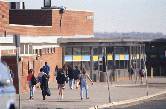
MONDAY, Jan. 14 (HealthDay News) — After New York City made the streets near some of its schools safer, the number of children struck by cars each year dropped substantially, a new study shows.
Researchers found that the rate of child pedestrian injuries during “school travel” hours fell by 44 percent around schools where the city made traffic changes. The changes included installing more traffic lights and speed bumps, putting islands in the center of wide streets, and setting up digital signs that tell drivers how fast they are going.
Experts say the findings point to the success of the National Safe Routes to School program, which was set up in 2005 to encourage kids to walk or ride their bikes to school.
“The study shows that safety programs really do work,” said Kate Carr, president and CEO of Safe Kids Worldwide, in Washington, D.C. “Making common sense improvements around schools by adding sidewalks and speed bumps, improving signage, and creating more visible crosswalks prevents injuries and saves lives.”
“At a time when we need more focus on decreasing driver and pedestrian distraction, programs like Safe Routes to School are more important than ever when it comes to the safety of our kids,” added Carr, who was not involved with the study.
The main motivation for the program originally was to get kids physically active and help curb childhood obesity. But based on the new findings, reported online Jan. 14 and in the February print issue of the journal Pediatrics, the program also may be protecting kids from potentially serious or fatal injuries.
“The reason so many kids aren’t walking to school is that parents are worried about safety, and one of their biggest concerns is the risk of pedestrian injury,” said study co-author Charles DiMaggio, an associate professor at Columbia University Medical Center in New York City.
The findings, DiMaggio said, suggest that the Safe Routes to School program may be preventing many of those injuries. But he and his colleagues still have to complete a national study to confirm that.
“We really need to see if the program is having similar effects elsewhere, outside of New York City,” DiMaggio said.
Nationally, the Safe Routes to School program allocated $612 million between 2005 and 2009 for states to improve sidewalks, streets and traffic patterns around schools. A program progress report released in August 2011 showed that 10,400 schools in all 50 states and Washington, D.C., had Safe Routes to School programs in place and that an estimated 4.8 million children were affected by the program.
New York City used its share of Safe Routes to School money to target 124 schools with the highest traffic injury rates; as of 2009, 30 schools had at least some safety measures in place.
DiMaggio’s team found that fewer children at those 30 schools were struck by vehicles in 2009 and 2010 compared with the period from 2001 to 2008.
During the before- and after-school hours when kids are on the street, the traffic injury rate among children and teens fell from eight per 10,000 to 4.4 per 10,000 — a 44 percent drop.
In contrast, the injury rate held steady around schools that had not received any safety improvements.
Dr. Karen Sheehan is medical director of the Injury Prevention and Research Center at Lurie Children’s Hospital of Chicago. She said, “One of the concerns of public health advocates has been, if we get children walking more to decrease obesity, are we putting them at risk for getting hit by a car because they will have more opportunities to be hurt?
“But this study shows that there are structural changes we can do to keep kids safe,” said Sheehan, who was not involved in the study.
DiMaggio agreed that the goals of getting kids outside to exercise and keeping them safe “need not be at odds.”
“You can do both,” he said. “Kids can be kids and still be safe.”
More information
Learn more about child pedestrian safety from the National Center for Safe Routes to School.

